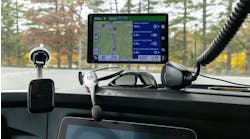How did the performance audit of the Worldwide account go? Did you review those five years' worth of delivery records this afternoon?” the fleet operations manager asks the avatar when his face appears on the office 4-ft. by 5-ft. LCD computer screen.
“Yes Sir, I did,” the avatar answers, “and I think there are some opportunities for increasing productivity and improving service at the same time. Would you like to hear them now, or shall I print a report for you to read on the plane? Your calendar shows that it is nearly time for you to go to the airport, Sir.”
“Thanks, Ed. I'll take that list for now and we'll talk later,” the manager says as he checks his father's wind-up Bulova wristwatch and grabs the battered leather briefcase he still prefers to carry.
It's 4:00 p.m., April 13, 2010. As he slides into the backseat of the waiting taxi, the operations manger thinks to himself, “I've been in this darn industry twenty years now and you'd think nothing would surprise me anymore, but who would have thought fleet management would change so much so quickly?”
Back in the present, William E. Halal, professor of management in the Dept. of Management Science at George Washington University and director of the TechCast Project, has been anticipating just such developments in intelligent computers and communications for some time.
“Information and communications technologies are rapidly converging to create machines that can understand us, do what we tell them to do and even anticipate our needs,” says Halal. “Technology scanning conducted under the TechCast Project at George Washington University indicates that advances in speech recognition, artificial intelligence (AI), powerful computers, virtual environments and flat wall LCD monitors are creating a conversation human-machine interface that should be part of mainstream business by about 2010. It will transform how we use computers and what they do for us.”
Hence, the operations avatar, or virtual robot. If Halal and others are correct, these on-screen agents will soon replace today's software tools run by humans via keystrokes and mouse clicks, in much the same way that the electrical appliances replaced mechanical ones early in the previous century.
In just a few years, instead of sitting at a keyboard, a fleet manager will literally ask an on-screen virtual helper to do a project or initiate a process, such as analyze a particular database for trends. The avatar might verbally present the results, too. In fact, several such smart agents (perhaps from a carrier and a shipper) might interact to compare information and initiate other programs on behalf of the companies involved.
If all this sounds far-fetched, consider the list of current artificial intelligence applications and initiatives Dr. Halal cites in his recent article for the Futurist (“The Intelligent Internet: The promise of smart computers and e-commerce,” March-April 2004). His long list includes Amtrak's virtual salesperson, which permits customers to do everything from order tickets to discuss complaints, to a female robot that delivers the weather reports in Japan. The U.S. Dept. of Energy is also creating an intelligent computer designed to infer intent, remember prior experiences, analyze problems and make decisions.
Will the advent of intelligent computers equipped with speaking “human” avatars as the user interface liberate workers at long last from the frustrations and drudgery of computer use then? “Not necessarily,” cautions Halal. “Just imagine shouting at an avatar who repeatedly fails to understand what you want it to do,” he says. Does that make you think about working with some of your fellow humans now? Thought so.


